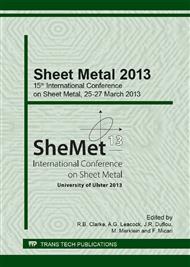[1]
Livermore Software Technology Corporation: LS-DYNA KEYWORD USER'S MANUAL, VOLUME II, Material Models, Version 971 / Release 6. Livermore Software Technology Corporation, (2012)
Google Scholar
[2]
Livermore Software Technology Corporation: LS-DYNA THEORY MANUAL, Version 2006. Livermore Software Technology Corporation, (2006)
Google Scholar
[3]
Akerstroem, P.: Modelling and Simulation of Hot Stamping, Lulea University of Technology, Ph.D. Thesis, 2006.
Google Scholar
[4]
Olle, P.: Numerische und experimentelle Untersuchungen zum Presshärten, Leibnitz Universität Hannover, Ph.D. Thesis, (2007)
Google Scholar
[5]
George, R.; Bardelcik, A.; Worswick, M. J.: Hot Forming of a Lab-Scale B-Pillar with Tailored Properties – Experiment and Modelling. Edited by Oldenburg, M.; Steinhoff, K.; Prakash, B.: 3. International Conference on Hot Sheet Metal Forming of High-Performance Steel. Auerbach: Wissenschaftliche Scripten, 2011, pp.31-37
Google Scholar
[6]
Naderi, M.: Hot Stamping of Ultra High Strength Steels, RWTH Aachen, Ph.D. Thesis, (2007)
Google Scholar
[7]
Voestalpine Produktprospekt phs-ultraform: Presshärtender Stahl von voestalpine. http://www.voestalpine.com/stahl/de/site/downloads/product_brochures.ContentPar.6767.File.tmp/phs_Folder_deu_i.pdf (06.12.2011)
DOI: 10.11129/detail.9783955530396.120
Google Scholar
[8]
BÄHR-Thermoanalyse GmbH: http://www.baehr-thermo.com/de/produkte/html/frame_produkte.html (27.08.2012)
Google Scholar
[9]
Wirthl, E.; Pichler, A.; Angerer, R.; Stiaszny, P; Hauzenberger, K.; Titovets, Y; Hackl, M: Determination of the Volume Amount of Retained Austenite and Ferrite in Small Specimens by Magnetic Measurements. International Conference on TRIP-Aided High Strength Ferrous Alloys, Vol. 1., 2002, pp.61-64
Google Scholar
[10]
DIN EN ISO 6507-1 (März 2006): Metallische Werkstoffe: Härteprüfung nach Vickers
Google Scholar
[11]
Bargel, H.-J.; Schulze, J.: Werkstoffkunde. 10., bearbeitete Auflage. Springer-Verlag. Berlin/Heidelberg, (2008)
Google Scholar
[12]
Koistinen, D. P.; Marburger, R. E.: A general equation prescribing the extent of the austenite-martensite transformation in pure iron-carbon alloys and plain carbon steels. Acta Metallurgica 7 (1959) 59 – 60
DOI: 10.1016/0001-6160(59)90170-1
Google Scholar
[13]
Hougardy, H.: Werkstoffkunde Stahl, Bd. 1: Grundlagen. Düsseldorf: Springer-Verlag. Berlin/New York/Tokyo: Verlag Stahleisen, (1984)
DOI: 10.1002/crat.2170200212
Google Scholar
[14]
Avrami, M.: Kinetics of Phase Change: General Theory. Journal of Chemical Physics Vol. 7 (1939) 1103 – 1112
Google Scholar
[15]
Kirkaldy, J. S.; Venugopalan, D.: Prediction of microstructure and hardenability in low alloy steels. In: Marder, A. R.; Goldstein, J. I.: International Conference on Phase Transformations in Ferrous Alloys, 1983, pp.125-148
Google Scholar
[16]
Livermore Software Technology Corporation: LS-DYNA KEYWORD USER'S MANUAL, VOLUME I, Version 971 / Release 6. Livermore Software Technology Corporation, (2012)
Google Scholar
[17]
Hippchen, P.; Meinhardt, J.; Panico, T.; Grass, H.; Lipp, A.; Fleischer, M.: Simulation des Presshärtens und industrielle Anwendung im Automobilbau. Edited by Europäische Forschungsgesellschaft für Blechverarbeitung: Produktionssysteme und –methoden für den Leichtbau – Wegbereiter zur E-Mobilität. Hannover: Druckteam GmbH, 2011, pp.319-333
Google Scholar
[18]
Engelmann, B.E.; Whirley, R.G.; Goudreau, G.L.: A Simple Shell Element Formulation for Large-Scale Elastoplastic Analysis. In: Analytical and Computational Models of Shells, Noor, A.K.; Belytschko, T.; Simo, J.C., Eds.: CED-Vol 3, ASME, New York, New York, (1989)
Google Scholar
[19]
Heinle, I.; Application of Evolutionary Strategies to Industrial Forming Simulations for the Identification and Validation of Constitutive Laws. Universität Leiden, Ph.D. Thesis, (2012)
Google Scholar
[20]
Harrington, J.: The desirability function. Industrial quality control: Journal of the American Society of Quality C, 1965, pp.494-498
Google Scholar
[21]
Lee, Seok-Jae; Pavlina, E. J.; Van Tyne, C. J.: Kinetics modeling of austenite decomposition for an end-quenched 1045 steel. Materials Science and Engineering A527 (2010) 3186 – 3194
DOI: 10.1016/j.msea.2010.01.081
Google Scholar
[22]
Li, V.; Niebuhr, D.; Meekisho, L.; Atteridge, D.: A Computational Model for the Prediction of Steel Hardenability. Metallurgical and Materials Transaction B, 1998, pp.661-672
DOI: 10.1007/s11663-998-0101-3
Google Scholar
[23]
Hippchen, P.; Merklein, M.; Lipp, A.; Fleischer, M.; Grass, H.; Craighero, P.: Untersuchung und Modellierung des Gefügeumwandlungsverhaltens für das indirekte Presshärten unter Serienprozessbedingungen. Edited by Merklein, M.: 7. Erlanger Workshop Warmblechumformung. Bamberg: Meisenbach-Verlag, 2012, pp.133-151
Google Scholar


